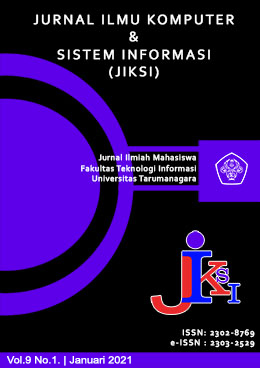PERANCANGAN SISTEM PENCARIAN LAGU INDONESIA MENGGUNAKAN QUERY BY HUMMING BERBASIS LONG SHORT-TERM MEMORY
Main Article Content
Abstract
Song identification dan query by humming is an application that is developed using Mel-frequency cepstral coefficients (MFCC) and Long Short-Term Memory (LSTM) algorithm.The application purpose is to detect and recognize humming from the input data. In this application the humming input will be divided into two parts, namely the training audio and test audio. For the training audio, the training audio will be divided into two process stages, namely recognizing humming and searching for the unique features of a humming audio.
To recognize the humming feature, the humming will be processed using the MFCC method. After obtaining a part of the MFCC Features, the MFCC features will be saved as a vector model. The feature that has been extracted will be learned by the LSTM method. For the test audio of the stages carried out as in the training audio, after the MFCC Feature is detected, an introduction will be made based on learning that has been done with the LSTM method to obtain output in the form of a song name that is successfully recognized and detected will be labeled by the application.
Article Details
This work is licensed under a Jurnal Komunikasi Creative Commons Attribution-ShareAlike 4.0 International License.
References
Wisnu Mintargo. Budaya Musik Indonesia. (Yogyakarta: Kanisius, 2018) .
Wayan Dadang, Memahami Kecerdasan Buatan berupa Deep Learning dan Machine Learning, https://warstek.com/2018/02/06/deepmachine learning/,Diakses 21 oktober 2020
Muhammad Wildan Putra Aldi.et,al. “Analisis dan Implementasi Long Short Term Memory Neural Network untuk Prediksi Harga Bitcoin”, e-Proceeding of Engineering, Vol.5 , Nomor 2, (Agustus, 2018)
Arintyo Archamadi,”Analisis Dan Simulasi Identifikasi Judul Lagu Dari Senandung Manusia Menggunakan Ekstraksi Ciri DCT (Discrete Cosine Transform)”, E-proceeding Of Engineering : Vol.III, Nomor.3 (December 2016)
Kuncoro Yoko, Viny Christanti M, Janson Hendryli, “Sistem Peringkas Otomatis Abstraktif Dengan Menggunakan Recurrent Neural Network”, Journal of Computer Science and Information Systems, Vol.2, Nomor 1, (April, 2018)
Mulyanti , Sistem Klasifikasi Irama Detak Jantung Menggunakan Deep Learning Long Short-term Memory, Jakarta: Program Studi Teknik Informatika Fakultas Teknologi Informasi Universitas Tarumanagara (Skripsi tidak Dipublikasikan), 2019
Belajar pembelajaran mesin Indonesia,Pengenalan Recurrent Neural Network (RNN) – Bagian 1, https://indoml.com/2018/04/04/pengenalan-rnn-bag-1/,diakses pada 27 September 2020
Budiman,Fajar et al.,”Pengenalan Suara Burung Menggunakan Melfrequency Cepstrum Coefficient Dan Jaringan Syaraf Tiruan Pada Sistem Pengusir Hama Burung ”,Jurnal Nasional Teknik Elektro,Vol: 5, No. 1,(Maret 2016)
Nasution,Torkis.”Metoda Mel Frequency Cepstrum Coefficients (MFCC) untuk Mengenali Ucapan pada Bahasa Indonesia”,Jurnal Sains dan Teknologi Informasi, Vol. 1, No. 1, (Juni 2012)
Risah Prayogi,Yanuar.Modifikasi Metode Ekstraksi Fitur Mel Frequency Cepstral Coefficient Untuk Identifikasi Pembicara Pada Lingkungan Berderau Menggunakan Residu Endpoint Detection,Surabaya:Program Magister Jurusan Teknik Informatika Fakultas Teknologi Informasi Institut Teknologi Sepuluh Nopember(Skrispi),2015
Tri Ramadhani ,Implementasi Algoritma Mel-frequency Cepstral Coefficients–vector Quantization (Mfcc-vq)untuk Deteksi Suara Burung Pemakan Padi Di Sawah,Medan: Fakultas Ilmu Komputer Dan Teknologi Informasi universitas Sumatera Utara(Skripsi),2018
Muhammad Gufindo Alenra,Penerapan Mel Frequency Cepstrum Coefficients (Mfcc) Dan Backpropagation Neural Network (Bpnn) Untuk Pengenalan Huruf Hijaiyah,riau:universitas Islam Negeri Sultan Syarif Kasim,2018
Marwa A.Nasr, et.al., “Speaker identification based on ormalized pitch frequency and Mel Frequency Cepstral Coefficient”, International Journal of Speech Technology , Vol.21, Issue 4,(Desember, 2018)
Agus Buono et.al.,“Perluasan Metode MFCC 1D ke 2D sebagai Ekstraksi Ciri pada Sistem Identifikasi Pembicara Menggn Hidden Markov Model (HMM)”, Makara Sains, Vol. 13, Nomor 1,(April 2009)



